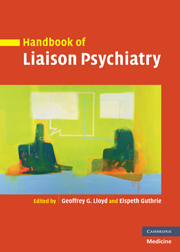Book contents
- Frontmatter
- Contents
- List of contributors
- Preface
- Part I Basic skills
- Part II Common psychiatric problems across the general hospital
- 7 Functional somatic syndromes
- 8 Alcohol problems in the general hospital
- 9 Drug misuse in medical patients
- 10 Sexual problems in medical patients
- 11 Suicide and deliberate self-harm
- 12 Delirium
- 13 Childhood experiences
- Part III Working with specific units
- Part IV Treatment
- Part V Different treatment settings
- Index
- References
12 - Delirium
from Part II - Common psychiatric problems across the general hospital
Published online by Cambridge University Press: 10 December 2009
- Frontmatter
- Contents
- List of contributors
- Preface
- Part I Basic skills
- Part II Common psychiatric problems across the general hospital
- 7 Functional somatic syndromes
- 8 Alcohol problems in the general hospital
- 9 Drug misuse in medical patients
- 10 Sexual problems in medical patients
- 11 Suicide and deliberate self-harm
- 12 Delirium
- 13 Childhood experiences
- Part III Working with specific units
- Part IV Treatment
- Part V Different treatment settings
- Index
- References
Summary
A short history of the concept of delirium
The term ‘delirium’ comes from the Latin expression de lira, literally ‘out of the furrow’, and was introduced by Celso (first century AD) to define an acute pathological state with alterations of consciousness, behavioural anomalies and fever. From the beginning, the relationship of delirium to intoxication and other conditions has been widely recognized (Fele et al. 1999; Lipowski 1980). Delirium was, in fact, one of the first psychiatric syndromes to be described.
In the nineteenth century, French psychiatrists introduced the concept of mental confusion as an acute psychotic state, independent of the cause (Chaslin 1892, 1895). Bonhoeffer noted that psychopathological phenomenology is not specific of organic aetiology (Bleuler 1967). Bonhoeffer, in 1909, defined delirium as a stereotypic manifestation of an acute cerebral disturbance, whilst Régis, in the same period, referred to toxic or infective causes.
Engel and Romano (1958), described typical electroencephalogram (EEG) pathological slow waves and considered the finding as distinctive of ‘cerebral insufficiency’, or ‘acute brain failure’; latterly, Lipowski contributed greatly to research on delirium and its diagnostic definition in the Diagnostic and Statistical Manual (DSM; 1980, 1990).
Epidemiology and risk factors
Delirium is frequent among medical and surgical patients and is one of the most common psychiatric complications, affecting 10–30% of patients in the general hospital (GH) (Cohen-Cole et al. 1998; Rigatelli & Ferrari 1999; Wise et al. 2002). It is one of the main diagnostic groups referred for psychiatric consultation (Huyse et al. 2000), although the prevalence varies widely due to differences in patient populations.
Keywords
- Type
- Chapter
- Information
- Handbook of Liaison Psychiatry , pp. 270 - 289Publisher: Cambridge University PressPrint publication year: 2007
References
- 1
- Cited by



